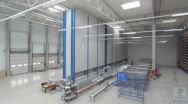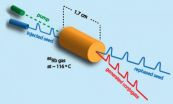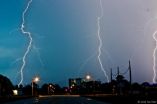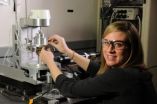(Press-News.org) RENO, Nev. – From the highest peak in the continental United States, Mt. Whitney at 14,000 feet in elevation, to the 10,000-foot-peaks near Lake Tahoe, scientific evidence from the University of Nevada, Reno shows the entire Sierra Nevada mountain range is rising at the relatively fast rate of 1 to 2 millimeters every year.
"The exciting thing is we can watch the range growing in real time," University of Nevada, Reno's Bill Hammond, lead researcher on the multi-year project to track the rising range, said. "Using data back to before 2000 we can see it with accuracy better than 1 millimeter per year. Perhaps even more amazing is that these miniscule changes are measured using satellites in space."
Miniscule as they may be, the data indicate that long-term trends in crustal uplift suggest the modern Sierra could be formed in less than 3 million years, which is relatively quick when compared to estimates using some geological techniques.
Hammond and his colleagues in the University's Nevada Geodetic Laboratory and University of Glasgow use satellite-based GPS data and InSAR (space-based radar) data to calculate the movements to this unprecedented accuracy. The calculations show that the crust moves upward compared to Earth's center of mass and compared to relatively stable eastern Nevada.
The data may help resolve an active debate regarding the age of the modern Sierra Nevada of California and Nevada in the western United States. The history of elevation is complex, exhibiting features of both ancient (40 million years) and relatively young (less than 3 million years) elevation. The "young" elevation is the uplift Hammond and colleagues have tracked.
"The Sierra Nevada uplift process is fairly unique on Earth and not well understood." Hammond said. "Our data indicate that uplift is distributed along the entire length of the 400-mile-long range, between 35 and 40 degrees north latitude, that it is active, and could have generated the entire range is less than 3 million years, which is young compared to estimates based on some other techniques. It basically means that the latest pulse of uplift is still ongoing."
Possibly contributing to the rapid uplift is the tectonic extension in Nevada and a response to flow in the mantle. Seismologists indicate the mountain range may have risen when a fragment of lower plate peeled off the bottom of the lithosphere allowing the "speedy" uplift, like a ship that has lost its keel. In comparison, other ranges, such as the Alps or Andes, are being formed in an entirely different process caused by contraction as two plates collide.
"We've integrated GPS and InSAR measurement techniques, drawing from experience we developed in the past five years in our work with tectonic deformation, to see how the Sierra is gradually being pushed upwards," Hammond said. "Combined with more GPS stations, and more radar data, detecting motions in the Earth is becoming more precise and ubiquitous. We can see the steady and constant motion of the Sierra in addition to episodic events such as earthquakes."
###
Hammond's team includes Geoff Blewitt, Hans-Peter Plag and Corné Kreemer from the University of Nevada, Reno's College of Science and Zhenhong Li of the Centre for the Observation and Modeling of Earthquakes, Volcanoes and Tectonics, School of Geographical and Earth Sciences, University of Glasgow in the UK.
GPS data for Hammond and his team's research is collected through the team's MAGNET GPS Network based at the University of Nevada, Reno plus more than 1200 stations from the NSF EarthScope Plate Boundary Observatory and more than 10,000 stations from around the entire planet. These stations include hundreds that cover Nevada, California, Oregon, and Washington. The space-based radar data comes from the European Space Agency with support from NASA.
This research was funded in the United States by the National Science Foundation and NASA and in the United Kingdom by the Natural Environment Research Council.
Their paper, "Contemporary Uplift of the Sierra Nevada, western United States, from GPS and InSAR Measurements" will be published in the peer-reviewed journal Geology in July and has just been made available online.
For more information on Hammond, go to http://www.nbmg.unr.edu/Staff/Hammond.html. For the Nevada Geodetic Laboratory go to http://geodesy.unr.edu.
The University of Nevada, Reno has the largest GPS data-processing center in the world, which processes information from about 10,000 stations around the globe continuously, 24/7. The Nevada Geodetic Laboratory has all publicly available GPS data going back to 1996 and reprocesses all 15-million data files as new data streams come in – every 30 seconds – solving for tens of thousands of parameters at once. It enables real-time positioning for any users. People around the world use it extensively for research such as modeling earthquakes and volcanoes. The information is freely available to anyone on the Internet.
Nevada's land-grant university founded in 1874, the University of Nevada, Reno has an enrollment of 18,000 students and is ranked in the top tier of the nation's best universities. Part of the Nevada System of Higher Education, the University has the system's largest research program and is home to the state's medical school. With outreach and education programs in all Nevada counties and with one of the nation's largest study-abroad consortiums, the University extends across the state and around the world. For more information, visit www.unr.edu.
Rapid Sierra Nevada uplift tracked by scientists at the University of Nevada, Reno
Nevada Geodetic Lab uses GPS and radar for most precise measurements over entire mountain range
2012-05-04
ELSE PRESS RELEASES FROM THIS DATE:
Next-generation nanoelectronics: A decade of progress, coming advances
2012-05-04
Traditional silicon-based integrated circuits are found in many applications, from large data servers to cars to cell phones. Their widespread integration is due in part to the semiconductor industry's ability to continue to deliver reliable and scalable performance for decades.
However, while silicon-based circuits continue to shrink in size in the relentless pursuit of Moore's Law — the prediction that the number of transistors that can fit on an integrated circuit doubles every two years — power consumption is rising rapidly. In addition, conventional silicon electronics ...
The Course is Set for the Liberalisation of the German Sports Betting Market - Market Expected to Grow to CA. Euro 1.5 Billion By 2015
2012-05-04
The German states will soon enact the new Interstate Treaty on Gambling, which will liberalise the German sports betting market starting in 2012. Liberalisation in general always sounds good, but the question is whether it will turn into a success story in Germany. Therefore, the consulting and research company MECN has analysed the situation in depth and compiled the most comprehensive and detailed report on the German betting and gambling market available.
Liberalising a giant gambling market
The discussion and legal disputes will surely continue in the coming months ...
Revolutionary technology enables objects to know how they are being touched
2012-05-04
PITTSBURGH—A doorknob that knows whether to lock or unlock based on how it is grasped, a smartphone that silences itself if the user holds a finger to her lips and a chair that adjusts room lighting based on recognizing if a user is reclining or leaning forward are among the many possible applications of Touché, a new sensing technique developed by a team at Disney Research, Pittsburgh, and Carnegie Mellon University.
Touché is a form of capacitive touch sensing, the same principle underlying the types of touchscreens used in most smartphones. But instead of sensing electrical ...
Low oxygen levels could drive cancer growth
2012-05-04
Athens, Ga. – Low oxygen levels in cells may be a primary cause of uncontrollable tumor growth in some cancers, according to a new University of Georgia study. The authors' findings run counter to widely accepted beliefs that genetic mutations are responsible for cancer growth.
If hypoxia, or low oxygen levels in cells, is proven to be a key driver of certain types of cancer, treatment plans for curing the malignant growth could change in significant ways, said Ying Xu, Regents-Georgia Research Alliance Eminent Scholar and professor of bioinformatics and computational ...
Southwest Solutions Group Selected Key Field Service Operations for KardexRemstar Products
2012-05-04
Southwest Solutions Group has been selected as a key field sales and service organization for KardexRemstar products. Services include layout and design, installation, relocations, parts, and routine service and preventative maintenance agreements for KardexRemstar products. Products include Vertical Lift Modules (VLM), Vertical Storage and Retrieval Carousels (VSR), and Lektriever Series 80, 90, 2000 electric filing cabinets throughout the states of Texas, Oklahoma, Arkansas, Louisiana, and Mississippi. "As a full service KardexRemstar Dealer, we are pleased that ...
New protocol enables wireless and secure biometric acquisition with web services
2012-05-04
Researchers at the National Institute of Standards and Technology (NIST) have developed and published a new protocol for communicating with biometric sensors over wired and wireless networks—using some of the same technologies that underpin the web.
The new protocol, called WS-Biometric Devices (WS-BD), allows desktops, laptops, tablets and smartphones to access sensors that capture biometric data such as fingerprints, iris images and face images using web services. Web services themselves are not new; for example, video-on-demand services use web services to stream videos ...
First light: NIST researchers develop new way to generate superluminal pulses
2012-05-04
Researchers at the National Institute of Standards and Technology (NIST) have developed a novel way of producing light pulses that are "superluminal"—in some sense they travel faster than the speed of light.* The technique, called four-wave mixing, reshapes parts of light pulses and advances them ahead of where they would have been had they been left to travel unaltered through a vacuum. The new method could be used to improve the timing of communications signals and to investigate the propagation of quantum correlations.
According to Einstein's special theory of relativity, ...
Fabrication method can affect the use of block copolymer thin films
2012-05-04
A new study by a team including scientists from the National Institute of Standards and Technology (NIST) indicates that thin polymer films can have different properties depending on the method by which they are made. The results* suggest that deeper work is necessary to explore the best way of creating these films, which are used in applications ranging from high-tech mirrors to computer memory devices.
Thin films spread atop a surface have many applications in industry. Inexpensive organic solar cells might be made of such films, to name one potential use. Typically ...
Science nugget: Lightning signature could help reveal the solar system's origins
2012-05-04
Every second, lightning flashes some 50 times on Earth. Together these discharges coalesce and get stronger, creating electromagnetic waves circling around Earth, to create a beating pulse between the ground and the lower ionosphere, about 60 miles up in the atmosphere. This electromagnetic signature, known as Schumann Resonance, had only been observed from Earth's surface until, in 2011, scientists discovered they could also detect it using NASA's Vector Electric Field Instrument (VEFI) aboard the U.S. Air Force's Communications/Navigation Outage Forecast System (C/NOFS) ...
Ultrasound idea: Prototype NIST/CU bioreactor evaluates engineered tissue while creating it
2012-05-04
Researchers at the National Institute of Standards and Technology (NIST) have developed a prototype bioreactor—a device for culturing cells to create engineered tissues—that both stimulates and evaluates tissue as it grows, mimicking natural processes while eliminating the need to stop periodically to cut up samples for analysis. Tissue created this way might someday be used to replace, for example, damaged or diseased cartilage in the knee and hip.
Conventional methods for evaluating the development and properties of engineered tissue are time-consuming, destructive ...
LAST 30 PRESS RELEASES:
Tracing the quick synthesis of an industrially important catalyst
New software sheds light on cancer’s hidden genetic networks
UT Health San Antonio awarded $3 million in CPRIT grants to bolster cancer research and prevention efforts in South Texas
Third symposium spotlights global challenge of new contaminants in China’s fight against pollution
From straw to soil harmony: International team reveals how biochar supercharges carbon-smart farming
Myeloma: How AI is redrawing the map of cancer care
Manhattan E. Charurat, Ph.D., MHS invested as the Homer and Martha Gudelsky Distinguished Professor in Medicine at the University of Maryland School of Medicine
Insilico Medicine’s Pharma.AI Q4 Winter Launch Recap: Revolutionizing drug discovery with cutting-edge AI innovations, accelerating the path to pharmaceutical superintelligence
Nanoplastics have diet-dependent impacts on digestive system health
Brain neuron death occurs throughout life and increases with age, a natural human protein drug may halt neuron death in Alzheimer’s disease
SPIE and CLP announce the recipients of the 2025 Advanced Photonics Young Innovator Award
Lessons from the Caldor Fire’s Christmas Valley ‘Miracle’
Ant societies rose by trading individual protection for collective power
Research reveals how ancient viral DNA shapes early embryonic development
A molecular gatekeeper that controls protein synthesis
New ‘cloaking device’ concept to shield sensitive tech from magnetic fields
Researchers show impact of mountain building and climate change on alpine biodiversity
Study models the transition from Neanderthals to modern humans in Europe
University of Phoenix College of Doctoral Studies releases white paper on AI-driven skilling to reduce burnout and restore worker autonomy
AIs fail at the game of visual “telephone”
The levers for a sustainable food system
Potential changes in US homelessness by ending federal support for housing first programs
Vulnerability of large language models to prompt injection when providing medical advice
Researchers develop new system for high-energy-density, long-life, multi-electron transfer bromine-based flow batteries
Ending federal support for housing first programs could increase U.S. homelessness by 5% in one year, new JAMA study finds
New research uncovers molecular ‘safety switch’ shielding cancers from immune attack
Bacteria resisting viral infection can still sink carbon to ocean floor
Younger biological age may increase depression risk in older women during COVID-19
Bharat Innovates 2026 National Basecamp Showcases India’s Most Promising Deep-Tech Ventures
Here’s what determines whether your income level rises or falls
[Press-News.org] Rapid Sierra Nevada uplift tracked by scientists at the University of Nevada, RenoNevada Geodetic Lab uses GPS and radar for most precise measurements over entire mountain range




